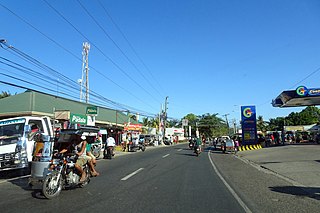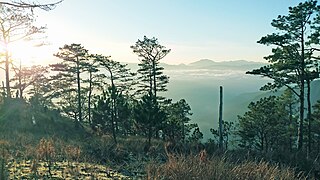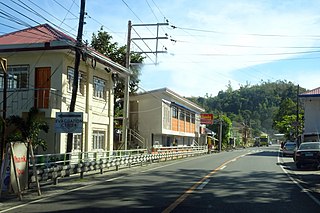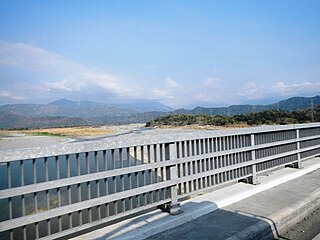
Ilocos Sur, officially the Province of Ilocos Sur, is a province in the Philippines located in the Ilocos Region in Luzon. Located on the mouth of the Mestizo River is the capital of Vigan. Ilocos Sur is bordered by Ilocos Norte and Abra to the north, Mountain Province to the east, La Union and Benguet to the south and the South China Sea to the west.

Narvacan, officially the Municipality of Narvacan, is a 2nd class municipality in the province of Ilocos Sur, Philippines. According to the 2020 census, it has a population of 46,234 people.

Tubo, officially the Municipality of Tubo, is a 4th class municipality in the province of Abra, Philippines. According to the 2020 census, it has a population of 5,674 people.

Banayoyo, officially the Municipality of Banayoyo, is a 4th class municipality in the province of Ilocos Sur, Philippines. According to the 2020 census, it has a population of 7,931 people.

Cervantes, officially the Municipality of Cervantes, is a 4th class municipality in the province of Ilocos Sur, Philippines. According to the 2020 census, it has a population of 19,449 people.

San Esteban, officially the Municipality of San Esteban, is a 5th class municipality in the province of Ilocos Sur, Philippines. According to the 2020 census, it has a population of 8,381 people.

Santa, officially the Municipality of Santa, is a 4th class municipality in the province of Ilocos Sur, Philippines. According to the 2020 census, it has a population of 14,992 people.

Santa Cruz (, officially the Municipality of Santa Cruz, is a 1st class municipality in the province of Ilocos Sur, Philippines. According to the 2020 census, it has a population of 41,366 people.

Santa Lucia, officially the Municipality of Santa Lucia, is a 3rd class municipality in the province of Ilocos Sur, Philippines. According to the 2020 census, it has a population of 25,966 people.

Santa Maria, officially the Municipality of Santa Maria, is a 3rd class municipality in the province of Ilocos Sur, Philippines. According to the 2020 census, it has a population of 30,006 people.

Tagudin, officially the Municipality of Tagudin, is a 2nd class municipality in the province of Ilocos Sur, Philippines. According to the 2020 census, it has a population of 41,538 people.

Abra, officially the Province of Abra, is a 3rd class province in the Cordillera Administrative Region of the Philippines. Its capital is the municipality of Bangued. It is bordered by Ilocos Norte on the northwest, Apayao on the northeast, Kalinga on the mid-east, Mountain Province on the southeast, and Ilocos Sur on the southwest.
The legislative districts of Abra are the representations of the province of Abra in the various national legislatures of the Philippines. The province is currently represented in the lower house of the Congress of the Philippines through its lone congressional district.
The legislative districts of Mountain Province are the representations of Mountain Province in the various national legislatures of the Philippines. The province is currently represented in the lower house of the Congress of the Philippines through its lone congressional district.

The University of Ilocos Philippines(UIP) (Filipino: Pampamahalaang Pamantasang Politekniko ng Ilokos Sur) formerly known as (Ilocos Sur Polytechnic State University or ISPSU) is a public college in the Philippines. It was founded in 1998 by the Philippine Congress. Its main campus is located in Santa Maria, Ilocos Sur.

Amburayan was an administrative division of the Philippines, existing as a politico-military comandancia from 1890 to 1902, and a sub-province from 1902 to 1920. Its territory encompassed most of the Amburayan River watershed, initially predominantly inhabited by the Kankana-ey.

The Amburayan River is a river in the northeastern portion of island of Luzon in the Philippines. It originates from the Cordillera mountains and traverses the provinces of Benguet, La Union, and Ilocos Sur. With a total length of 96 km (60 mi) where it empties into South China Sea.

Lepanto-Bontoc was a province of the Philippines, existing from 1902 to 1908. The province encompassed much of the central section of the Cordillera mountains in Luzon. Its capital was Cervantes, in the sub-province of Lepanto.

Ilocos Sur's 2nd congressional district is one of the two congressional districts of the Philippines in the province of Ilocos Sur. It has been represented in the House of Representatives of the Philippines since 1916 and earlier in the Philippine Assembly from 1907 to 1916. The district consists of the city of Candon and adjacent municipalities of Alilem, Banayoyo, Burgos, Cervantes, Galimuyod, Gregorio del Pilar, Lidlidda, Nagbukel, Narvacan, Quirino, Salcedo, San Emilio, San Esteban, Santa, Santa Cruz, Santa Lucia, Santa Maria, Santiago, Sigay, Sugpon, Suyo and Tagudin. It is currently represented in the 19th Congress by Kristine Singson-Meehan.
Ilocos Sur's 3rd congressional district was one of the three congressional districts of the Philippines in the province of Ilocos Sur in existence between 1907 and 1919. It was created in 1907 from former territories of the province under Philippine Commission Act No. 1582 following the passage of the 1902 Philippine Organic Act. The district was originally composed of the municipalities of Bangued, Bucay, Dolores, La Paz, Pilar, San Quintin and Santa, most of which were located in Abra, a sub-province of Ilocos Sur since 1905. It was a single-member district throughout the three legislatures of the Philippine Assembly from 1907 to 1916 and the first legislature of the House of Representatives from 1916 to 1919.




















